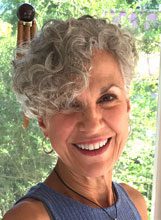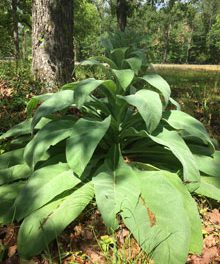 Take a walk with me (six feet apart!). Right up front I’ll tell you that this is not a power walk. Our goal is not to rack up 10,000 steps. Instead, our pace will be that of a good old fashioned lollygagging stroll. Let’s turn into Pigeon Point Park. Step off the sidewalk onto the crunch of the fine gravel path that meanders through the park among islands of gardenia, azalea, and hydrangea shrubs often quivering with busy butterflies and bees.
Take a walk with me (six feet apart!). Right up front I’ll tell you that this is not a power walk. Our goal is not to rack up 10,000 steps. Instead, our pace will be that of a good old fashioned lollygagging stroll. Let’s turn into Pigeon Point Park. Step off the sidewalk onto the crunch of the fine gravel path that meanders through the park among islands of gardenia, azalea, and hydrangea shrubs often quivering with busy butterflies and bees.
Out of the world of quarantine to which we woke up with a million things to do, or not do, we simply enter this tree-filled sanctuary where we are going to do just one thing — bathe in the beauty of the moment, scrolling down through our senses rather than the screens on our devices, lifting our faces up to the sheltering boughs of the moss drenched Live Oaks, opening our ears to the joyous song of the Mockingbirds, and filling our lungs fully with the fragrant air of the Lowcountry. A time for submersion and immersion, let’s soak in the sights, sounds, taste, and touch of nature and allow them to run over and down into our skin to seep into our heart and soul. When we return to the day that we put on hold for a moment, we will feel refreshed, more creative, and healthier. This is what “forest bathing” is all about.
The term “forest bathing” is taken from the Japanese phrase Shinrin-yoku, which describes a nature-oriented practice organized in the 1980s that became the foundation of preventive health care and healing in Japanese medicine. Shinrin-yoku inspired the research-based framework of forest therapy in the United States, developed and promoted by M. Amos Clifford, Founder of the Association of Nature and Forest Therapy Guides and Programs (ANFT) in 2012. Training of guides draws on the latest medical research, new developments in the field of nature connection, and ancient traditions of mindfulness and wellness promotion. As of the end of 2018, the organization has trained over 700 guides who are working with this practice in 46 countries. The ANFT provides a structure for forest bathing with a sequence of steps to ease the transition from the hectic pace of modern life to the tranquility and serendipity inherent in a natural setting. The organization’s website is full of inspiring stories, information on research efforts and health benefits, and how to locate a guide in your area.
Clifford began his career in 1972 as a wilderness guide. In his 2018 book, “Your Guide to Forest Bathing: Experience the Healing Power of Nature,” he explains that it took him a long time to “awaken to the power of the places in which I stood.” Years of meditation and the study of Zen Buddhism eventually enabled him to slow down, pay attention, and remember that human beings are not separate from nature. After all, human beings evolved in nature. We partner with trees as they take up the carbon dioxide we exhale and give us oxygen in return. Essential oils provided by trees benefit our immune systems, reduce levels of stress hormones, and improve our cognitive function and mood. Simply walking in a forest, on a beach, or through a peaceful meadow switches on the relaxation response allowing blood pressure and blood sugar to normalize. Even a guided meditation where we experience nature in our mind can have the same effect.
Now, think of a tree that was, or is, important to you. A tree you climbed as a child, a tree that whispered to you at night outside your bedroom window, a tree that blossomed in the spring and sprinkled your yard with fragrant petals. A tree that floods your front porch with a golden glow in autumn, or cools your patio with patches of shadow in summer. A tree that you mourned when it lost its struggle with hurricane winds or a raging chainsaw. A tree that inspired you to cope at a difficult time. On a personal note, a stand of trees stripped of their leaves by icy gusts off Ohio’s Lake Erie became a lifesaving focus for me years ago during a deep depression. The delicate tracery of their branches and their unique shapes, hidden under heaving masses of green in summer, were revealed in the honesty of winter. I stared out of my window at them for hours as their gnarled, broken branches, with their ever-present upward surge of continued growth, told me stories of how they survived great trauma and potential death at the hands of both nature and man. Those trees helped me realize that I, too, had the power to overcome the despair and self-destructive leanings in my own human nature and embrace the life force that runs through all of creation. Instinctively, I had found healing and comfort in a dose of self-administered forest therapy by simply being present with those trees outside my window. Nature is constant and always there to offer strength if we can spend some time with it.
A walk in the forest can be a challenge in the Lowcountry. We share this stunning landscape with fire ants, ticks, chiggers, and mosquitoes, not to mention an occasional venomous snake or two. However, if you gear up appropriately for the maritime forest, or simply take a walk on the beach, down your street, or in your yard, you can share in the benefits to mind, body and soul that forest bathing has to offer. In his book, Clifford offers “invitations” arranged around the four elements of earth, air, fire, and water as a gentle way to inspire your walk.
See nature as a partner, focus on sensory experience and have no expectations. Just observe and be present with what is, wherever you are, without any need to consider it a meditation or a workout. Move slowly. You do not have to go far at all, your own back porch is enough. Most of all, be sure to unplug.
Go out with intention and create a threshold of connection so it is not just another walk. For example, find a landmark or place a stick or stone at the spot where your walk will begin and to where you will return. Take a moment for gratitude and reverence. Be open to what draws your attention and see what invites you into exploration with each of your senses, or choose one sense to explore in depth. Proceed with awareness of how your feet feel on the earth, the warmth of the sunlight on your cheek, the movement of your hair in the wind, a spicy herbal scent that makes your mouth water, the sound of scratchy squirrel feet scurrying up the prickly trunk of a Palmetto, or the way Sycamore leaves give you a friendly wave in the breeze. Find what Clifford calls a “sit spot,” maybe a place where you can return often and linger at least 15 minutes to observe and listen to the life around you, and feel how your body, mind, and soul relax into the gentle rhythm of nature.
The words of naturalist and author John Muir (1838-1914) fit the forest bathing experience well: “In every walk with nature one receives far more than he seeks.”
Carolyn Jirousek grew up in Cleveland, Ohio. She and her husband, Bill, divide their time between Cleveland and Beaufort, enjoying the best of both worlds. She is a Reiki Practitioner, Registered Nurse with a Masters Degree in Art History, Master Naturalist, and volunteer in both North and South with several non-profit organizations.








